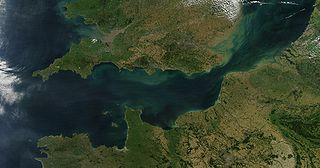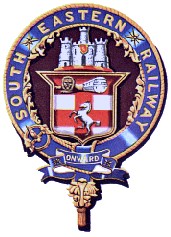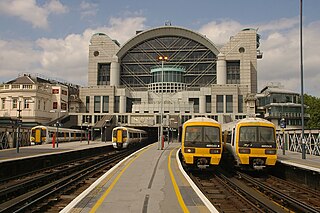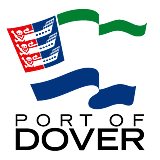
The English Channel, also called simply the Channel, is an arm of the Atlantic Ocean that separates Southern England from northern France and links to the southern part of the North Sea by the Strait of Dover at its northeastern end. It is the busiest shipping area in the world.

Dover is a town and major ferry port in Kent, South East England. It faces France across the Strait of Dover, the narrowest part of the English Channel at 33 kilometres (21 mi) from Cap Gris Nez in France. It lies south-east of Canterbury and east of Maidstone. The town is the administrative centre of the Dover District and home of the Port of Dover. The surrounding chalk cliffs are known as the White Cliffs of Dover.

Folkestone is a port town on the English Channel, in Kent, south-east England. The town lies on the southern edge of the North Downs at a valley between two cliffs. It was an important harbour and shipping port for most of the 19th and 20th centuries.

Boulogne-sur-Mer, often called just Boulogne, is a coastal city in Northern France. It is a sub-prefecture of the department of Pas-de-Calais. Boulogne lies on the Côte d'Opale, a touristic stretch of French coast on the English Channel between Calais and Normandy, and the most visited location in the region after Lille conurbation. Boulogne is its department's second-largest city after Calais, and the 183rd-largest in France. It is also the country's largest fishing port, specialising in herring.

The Strait of Dover or Dover Strait, historically known as the Dover Narrows, is the strait at the narrowest part of the English Channel, marking the boundary between the Channel and North Sea, separating Great Britain from continental Europe. The shortest distance across the strait, 33.3 kilometres, is from the South Foreland, northeast of Dover in the English county of Kent, to Cap Gris Nez, a cape near to Calais in the French département of Pas-de-Calais. Between these points lies the most popular route for cross-channel swimmers. The entire strait is within the territorial waters of France and the United Kingdom, but a right of transit passage under the UNCLOS exists allowing unrestricted shipping.

The South Eastern Railway (SER) was a railway company in south-eastern England from 1836 until 1922. The company was formed to construct a route from London to Dover. Branch lines were later opened to Tunbridge Wells, Hastings, Canterbury and other places in Kent. The SER absorbed or leased other railways, some older than itself, including the London and Greenwich Railway and the Canterbury and Whitstable Railway. Most of the company's routes were in Kent, eastern Sussex and the London suburbs, with a long cross-country route from Redhill in Surrey to Reading, Berkshire.
Hoverspeed was a ferry company that operated on the English Channel from 1981 until 2005. It was formed in 1981 by the merger of Seaspeed and Hoverlloyd. Its last owners were Sea Containers; the company ran a small fleet of two high-speed SeaCat catamaran ferries in its final year.

Sealink was a ferry company based in the United Kingdom from 1970 to 1984, operating services to France, Belgium, the Netherlands, Channel Islands, Isle of Wight and Ireland.

The South Eastern main line is a major long-distance railway route in South East England, UK, one of the two main routes crossing the county of Kent, going via Sevenoaks, Tonbridge, Ashford and Folkestone to Dover. The other route is the Chatham main line which runs along the north Kent coast to Ramsgate and Dover via Chatham.

Folkestone Harbour station was built to serve the port of Folkestone in Kent, one of four railway stations in the town. It was at the end of the short 1-in-30 Folkestone Harbour Branch Line which joined the South Eastern Main Line at Folkestone Junction. The branch and harbour station were provided for boat trains from London which connected with the ferry services to Calais and Boulogne.

LD Lines was a French shipping company, with both roro freight and passenger ferry operations. It was a subsidiary of Louis Dreyfus Armateurs (LDA), which engages in building, owning, operating, and managing vessels. LD Lines operated ferry routes on the English Channel, the Bay of Biscay and the Mediterranean Sea.

The Port of Dover is the cross-channel port situated in Dover, Kent, south-east England. It is the nearest English port to France, at just 34 kilometres (21 mi) away, and is one of the world's busiest passenger ports, with 11.7 million passengers, 2.6 million lorries, 2.2 million cars and motorcycles and 80,000 coaches passing through it in 2017, with an annual turnover of £58.5 million a year. The Channel Tunnel in nearby Cheriton now takes an estimated 20 million passengers and 1.6 million trucks.

The Dover Strait coastal guns were British and German long-range coastal artillery pieces, on the English Channel coasts of Kent, England and the Pas-de-Calais, occupied France. The Strait of Dover is the narrowest channel between England and continental Europe. During the Second World War, both sides used their guns to bombard shipping in the Channel as well as coastal towns and military installations.
The Channel Ports are seaports in southern England and the facing continent, which allow for short crossings of the English Channel. There is no formal definition, but there is a general understanding of the term. Some ferry companies divide their routes into "short" and "long" crossings. The broadest definition might be from Plymouth east to Kent and from Roscoff to Zeebrugge although a tighter definition would exclude ports west of Newhaven and Dieppe. A historic group of such ports is the Cinque Ports of south-east England, most of which have ceased to be commercial ports.

Folkestone Harbour is the main harbour of the town of Folkestone in Kent, England.

SS (RMS) Mona's Isle (IV) was a steel, triple-screw turbine driven packet steamer operated by the Isle of Man Steam Packet Company between 1920 and 1948. Built in 1905 for the South Eastern & Chatham Railway Company, she was operated as Onward between Folkestone and Boulogne. In 1918 a fire was only controlled by scuttling the vessel. She was righted and in 1920, the hull was purchased by IOMSPCo to replace tonnage lost during the war. She was the first ship to complete a round trip during the evacuation of Dunkirk, rescuing a total of 2,634 troops.
Vortigern was a 4,797 GRT combined train and roll-on/roll-off ferry built by Swan Hunter in 1969 for the British Railways Board. She was sold to Greece in 1988 and served until 2004 under the names Milos Express, Express Milos and Nisos Lemnos. She was renamed Limon in 2004 and reflagged to Saint Vincent & the Grenadines and the Grenadines. Limon was scrapped in 2005.

The MV Al Salmy 4 is a former train ferry, converted to RO-RO/Passenger ferry, owned by SAMC.

The Port of Calais is a port in Calais, northern France. The port is the fourth largest port in France and the largest for passenger traffic. It accounts for more than a third of economic activity in the town of Calais.
Water Witch was an early British wood-hulled paddle steamer, built in 1835 at Harwich, England for steam packet services from Dover to London and to Boulogne. A successful fast ship, she was later operated on services on the South Coast of England and in the Bristol Channel















